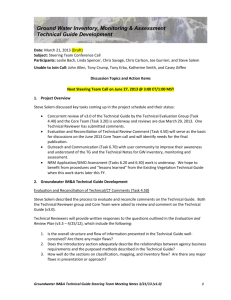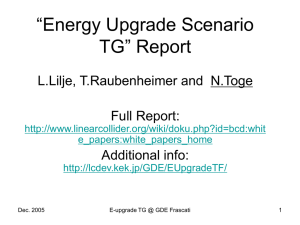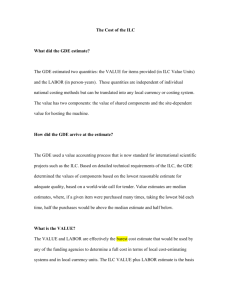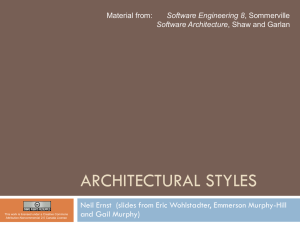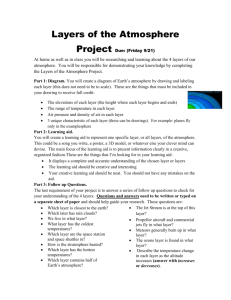Core Team 10/31/2013 Call Notes
advertisement
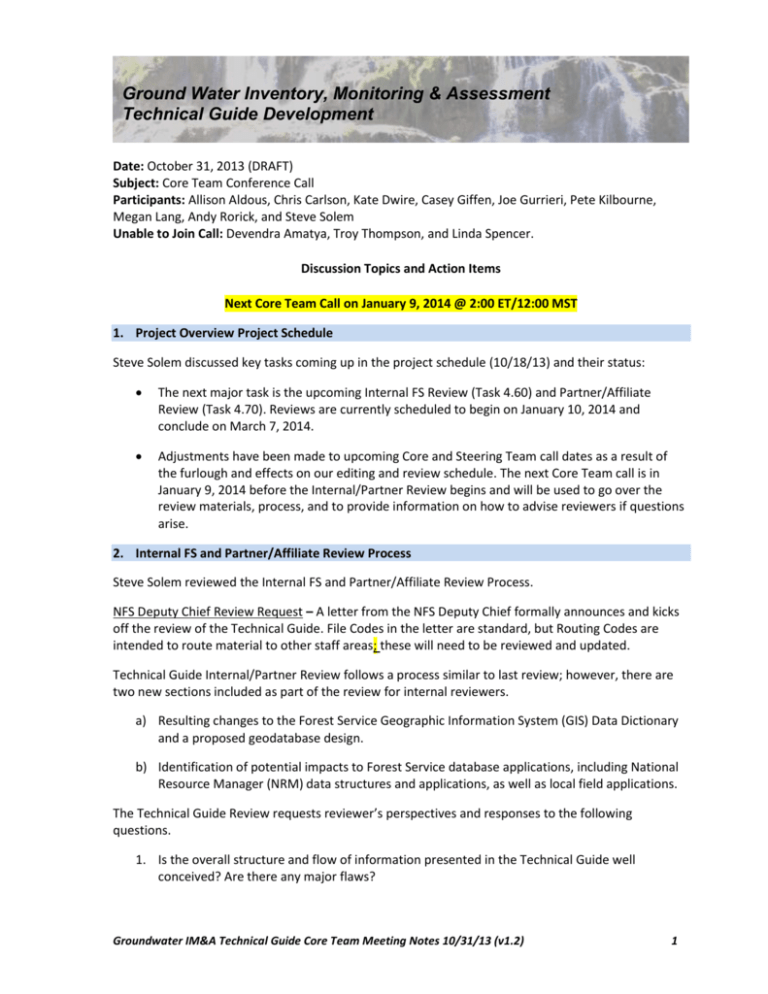
Ground Water Inventory, Monitoring & Assessment Technical Guide Development Date: October 31, 2013 (DRAFT) Subject: Core Team Conference Call Participants: Allison Aldous, Chris Carlson, Kate Dwire, Casey Giffen, Joe Gurrieri, Pete Kilbourne, Megan Lang, Andy Rorick, and Steve Solem Unable to Join Call: Devendra Amatya, Troy Thompson, and Linda Spencer. Discussion Topics and Action Items Next Core Team Call on January 9, 2014 @ 2:00 ET/12:00 MST 1. Project Overview Project Schedule Steve Solem discussed key tasks coming up in the project schedule (10/18/13) and their status: The next major task is the upcoming Internal FS Review (Task 4.60) and Partner/Affiliate Review (Task 4.70). Reviews are currently scheduled to begin on January 10, 2014 and conclude on March 7, 2014. Adjustments have been made to upcoming Core and Steering Team call dates as a result of the furlough and effects on our editing and review schedule. The next Core Team call is in January 9, 2014 before the Internal/Partner Review begins and will be used to go over the review materials, process, and to provide information on how to advise reviewers if questions arise. 2. Internal FS and Partner/Affiliate Review Process Steve Solem reviewed the Internal FS and Partner/Affiliate Review Process. NFS Deputy Chief Review Request – A letter from the NFS Deputy Chief formally announces and kicks off the review of the Technical Guide. File Codes in the letter are standard, but Routing Codes are intended to route material to other staff areas; these will need to be reviewed and updated. Technical Guide Internal/Partner Review follows a process similar to last review; however, there are two new sections included as part of the review for internal reviewers. a) Resulting changes to the Forest Service Geographic Information System (GIS) Data Dictionary and a proposed geodatabase design. b) Identification of potential impacts to Forest Service database applications, including National Resource Manager (NRM) data structures and applications, as well as local field applications. The Technical Guide Review requests reviewer’s perspectives and responses to the following questions. 1. Is the overall structure and flow of information presented in the Technical Guide well conceived? Are there any major flaws? Groundwater IM&A Technical Guide Core Team Meeting Notes 10/31/13 (v1.2) 1 2. Does Section 2 adequately describe the conceptual framework used, relationships between agency business requirements, and the relationships to methods described in the Technical Guide? 3. How well do the technical descriptions and methods presented in Sections 3 through Section 5 flow? Are there any technical flaws in presentation or approach? Is there an appropriate amount of detail and discussion? 4. Are there changes to the Technical Guide that should be considered? Are there missing components? 5. What impacts to your organization may result from using the technical guidance? Do you have specific thoughts regarding user training or implementation of this guidance that should be considered? a. Benefits/Consequences: What benefits to partnerships, data sharing, and improved efficiency do you envision? Do you foresee any unintended consequences as a result of applying these procedures? b. Transition Costs: Are there changes or adaptations needed to information systems or inventory/monitoring systems to make them compatible with the guidance? c. Capacity of personnel to understand and use: Are the skills and training of potential users adequate to understand and apply the guidance? What training opportunities would help users? Reviewers are asked to consolidate comments into one response per Region, Station, Area, or Washington Office staff area. An external website will be set up for the Internal/Partner Review of the Technical Guide to serve as a common gateway to access project documentation and review guidelines and to provide internal reviewers access to SharePoint sites. An Internal FS SharePoint will be set up for the FS Application Dependency Assessment and a SharePoint will be established for review and comment on changes to the Data Dictionary/Geodatabase Design Detailed information about the review process for the GIS Data Dictionary and Geodatabase Design will be posted on the FS GIS Data Dictionary Update Project website. Partner and Affiliate Review Process This review will focus on the five review questions identified in the NFS Deputy Chief’s letter. Chris Carlson will notify each of the partners and provide them information on the review process. Because external partners cannot access FS SharePoint sites we will not be requesting comments on the FS Application Dependency Assessment and Data Dictionary/Geodatabase Design using this process. We will need to make sure our list of reviewers is up-to-date in late November so Chris Carlson can provide reviewers advance notice and let them know about the upcoming review and how to access documents and provide comments. Action: Core Team members should send corrections to the Routing Codes in Deputy Chief letter to Steve Solem and Chris Carlson. Send updates to the Partner and Affiliate Review Roster (additional reviewers, corrections to the list) to Chris Carlson, Joe Gurrieri, and Steve Solem by November 15. Groundwater IM&A Technical Guide Core Team Meeting Notes 10/31/13 (v1.2) 2 3. GIS Data Dictionary/Geo-Database Design Pete Kilbourne gave an overview of the different Data Dictionary development efforts. We are working on common map layers needed to support consistent development and capture of geospatial information developed while implementing the (a) Groundwater Dependent Inventory Field Guides and (b) the Groundwater Inventory, Monitoring and Assessment Technical Guide. Basic map layers define geospatial data and attributes associated with data. A total of six map layers are being defined: Hydro-Geologic Observations – Will consist of two map layers (Points and Polygons) for recording basic observations of springs and wetlands that may be supported by groundwater. GDE Features or Sites – Will consist of two map layers (Points and Polygons) for recording locations and aerial extent of GDE features such as springs, fens and other groundwater wetlands from Level I and II GDE inventories. Hydrogeologic Units – Correspond to Figures 2-1 (Legend) and 2-2 (Map of the Fishlake NF) in the IM&A Technical Guide. Aquifer Vulnerability – Correspond to Figures 6-1 (Map of a portion of the BeaverheadDeerlodge NF) and 6-2 (DRASTIC Model or legend for the map). Pete then provided additional detail on each of these six layers and their purposes. Observation layers (2 layers) – This set of layers is designed to capture initial observations of springs and other potential groundwater dependent ecosystem sites and features. A point layer captures smaller features such as springs and a polygon layer captures larger hydrofeatures such wetlands. The attributes associated with these layer will be defined using a combination of the GDE Field Guide attributes from the GDE Database and other nationally defined classifications such as from the National Wetlands Inventory and Army Corps of Engineers. Domains allowing dropdown data entry are provided for many fields. These layers would reside in the unit’s GIS library as Hydro-Geologic Observations (poly and pt) available for use by all employees. Methods for controlling data entry would be dependent on the unit’s workflow and be controlled by the hydrology data steward and GIS Data Manager. The intent, however, is to allow the ability for employees to contribute observations without undue barriers. Observation data could be collected by a variety of observers such fire, wildlife, or range monitoring crews, then entered into the layers. At the initial observation stage it may not be possible to distinguish groundwater dependent features from similar surface water dependent features. Therefore, these layers become a repository for both. The data dictionary could be loaded on field recorders to facilitate data capture. Larger features could be digitized directly into the layers using high resolution background imagery (e.g., CIR NAIP imagery). Other sources of data to populate the observation layers could include: spring locations noted on USGS quads or in NHD data and other legacy datasets, for example forest generated spring and wetland inventories. The purposes of these layers are: To capture initial observations of GDE features/sites or potential sites for more detailed inventory (i.e., Level I or Level II GDE inventory) if there is a business need. At Groundwater IM&A Technical Guide Core Team Meeting Notes 10/31/13 (v1.2) 3 the initial observation stage, it may not be possible to distinguish groundwater dependent features from similar surface water dependent features. These layers become a repository for both. To record potential sites or features that can be used to address potential effects during project design, and analysis, which is an important business needs on all NF units. Having information on the location of these features for project planning meets an important business need as demonstrated by agency staff who have been participating in the “0.5 GDE inventory group” discussions. GDE Layers (2 layers) - There are two layers associated with inventories resulting from use of the GDE Field Guides – a point and polygon layer of GDE features or sites. The point layer will typically capture the location of smaller springs (point feature) and the polygon layer will capture the extent of larger features such as groundwater-supported wetlands and more extensive spring sites. The point and polygon information will be linked to the GDE database and eventually the NRM application that replaces the MS Access database. Domain or attribute information for these layers is identical to the choices in the GDE database so they are aligned and provide the ability to transfer between systems. In terms of workflow and relationships between the “Observation” and “GDE Layers”: The observation layers provide users a way to record “casual” observation of springs and wetlands by a variety of observers as described above. Information on sites may be entered into the GDE database once verified by a data steward. The observation layers provides a set of candidate sites and features that can be selected for GDE field review based on a sampling design. If a decision is made to conduct more detailed inventories of these sites using the GDE Field Guide methods, the results of the Level I and II inventories would be recorded in the GDE Database and the associated GDE GIS layers. GDE field inventories might be conducted directly, bypassing the observation step. It would be at the unit’s discretion whether to replicate that data to the observation layer. Hydrogeologic Units Layers (1 layer) – This layer results from the reclassification of geologic units to represent their groundwater characteristics. See the Groundwater IM&A Technical Guide for Figure 2-1 for an example of the Hydrogeologic Units on Fishlake NF. Aquifer vulnerability Layer (1 layer) – This layer is typically produced using the DRASTIC model as described in Section 6 of the IM&A Technical Guide, figures 6-1 and 6-2. This layer identifies specific aquifers that are potentially at risk. Pete K. has been working with Utah Geological Survey to get their technical expertise on and discuss the practicality of some of these approaches and layers. The Survey has direct experience working with the GDE inventories and GIS layers under a cost share agreement with the Manti-La Sal National Forest and can share their perspectives on how to develop and use these data outside the FS firewall. Steve Solem mentioned that this work might also benefit from a discussion with TNC to find out what data dictionary/Geodatabase Design will be useful to them. Allison Aldous said there might be a GIS analyst in her office that could provide technical feedback on the data dictionary and Geodatabase Design. Steve suggested January-February 2014 would be a good time to get feedback from TNC. Core Team Comments Groundwater IM&A Technical Guide Core Team Meeting Notes 10/31/13 (v1.2) 4 There was considerable discussion and confusion over how these layers related to entries in the GDE database, the Enterprise Data Warehouse, and NRM. In summary, the key point from this discussion is that data from these observations will not be entered into the GDE database or NRM unless verified by a data steward with access to these systems. There was concern about the use of an “index card” for recording observations by different staff on Ranger Districts and the potential for loosing this information or not recording the information in the GIS Observation Layer or GDE database. Andy Rorick commented that he is concerned about the process (i.e., where will the data be stored until entered) someone has to follow before data will be entered into the Observation Layer, GDE Layer, and GIS Data Dictionary. Chris Carlson commented that the responsibility falls to the data steward to enter the information collected during a site visit into the database. The data steward needs to keep ownership of data, including the index cards, until it is entered into the system. Members of the Core Team also inquired about the relationship between the observation layers and entries into the GDE database (e.g., the “0.5 inventory). Steve Solem explained that the GDE database allows users to enter a minimal amount of information for each site visit. The GDE database does not require the full set of GDE Level I or II data to be entered. Information from each site visit (including Level I or II inventories) can be entered into the database. This capability provides for the capture of information on site conditions, etc. without the need for a “0.5 Inventory” or minimum data set. To enter this information in the GDE database, users with access permissions only need to note the date of the observation and enter the appropriate data (e.g. a photograph or note about disturbance). As a result, there is no need for a separate “0.5 GDE Inventory”. Pete Kilbourne also explained that he and Linda Spencer (NRM) have discussed a mechanism to link information from the Observation layer to GDE database. Providing an automated process for populating the GDE database from the observation layer would change the scope of the current NRM project. This capability will be needed at some point to avoid having the data steward re-key all the information from the observation layer for a site the elect to enter into the GDE database. FS Application Dependency Assessment - This assessment will allow internal reviewers to provide comments about different FS corporate applications (including NRM applications) and their relationship to groundwater inventory, monitoring, and assessment processes. If there are functions that are not currently being met by NRM or other applications, users can help identify these needs so they can be included in the development of the NRM Requirements Analysis that is used to identify changes and additions to NRM and other FS applications. Link to the “0.5 GDE Inventory” Discussions – Pete has a prototype of the “Observation Layer” and supporting Geodatabase Design. During the Core Team discussion, Joe asked if there was an opportunity to brief the group who had been involved in the “0.5 observation database” discussion. The purpose of this discussion was to make sure the proposed solution meets the needs identified by this group prior to the internal FS review. Pete agreed to brief Joe Gurrieri on the design and to set up a discussion with the “0.5 group”. Pete and Joe will work out these details. Actions: Joe and Pete will discuss the observation layer prototype and a discussion with the “0.5 inventory discussion group”. We will set up a process to allow TNC to review and comment on the GIS Data Dictionary and Geodatabase design during the partner review period (Pete Kilbourne will work with Allison Aldous). Groundwater IM&A Technical Guide Core Team Meeting Notes 10/31/13 (v1.2) 5 4. Revision of TG for Managing Groundwater Resources The effort to revise this Technical Guide will start at the beginning of next year. The first step of this process is to define the scope of the revision effort. Steve Solem took a first cut at identifying the potential scope using the outline of the Technical Guide as an index for changes. The analysis identifies: a) b) c) d) Content moved to IM&A Technical Guide and accompanying Technical Notes, Information that could be included in a new set of Technical Notes, Information that needs to be consistent with the new IM&A Technical Guide, and Ideas on new areas of discussions such as climate change, secondary and tirtiatry oil and gas extraction methods such as“fracking”, and determining environmental flows and levels Joe Gurrieri asked the Core Team to review the analysis and offer ideas on additional changes for discussion on the January 9 call. Action: Core Team members review the revision scope analysis and provide Joe Gurrieri suggestions by November 22. Groundwater IM&A Technical Guide Core Team Meeting Notes 10/31/13 (v1.2) 6
